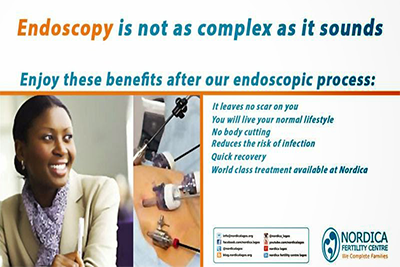Endoscopy: How Is It Done?
Endoscopy: How Is It Done?

Endoscopy means looking inside and typically refers to looking inside the body for medical reasons using an endoscope, a fibreoptic instrument used to examine the interior of a hollow organ or cavity of the body.
There are varying types of endoscopic procedures and usually are named after the cavity or hollow organ being investigated. However, the ones commonly used in gynecological cases are the laparoscopy and Hysteroscopy.
Laparoscopy
Laparoscopy, a minimally invasive procedure or keyhole procedure, is a modern surgical technique in which operations are performed far from their location through small incisions (usually 0.5–1.5 cm) elsewhere in the body. It is used to find problems such as cysts, adhesions, fibroids and infection. Tissue samples can be taken for biopsy through the tube (laparoscope).
Benefits Of Endoscopy In IVF
To diagnose tubal factor infertility especially when used with a dye test.
- To remove adhesion bands around the tubes and or ovaries.
- To remove or burn off endometriosis deposits anywhere found; tubes, ovaries, cu-de-sac, etc., whenever possible.
- Sometimes to treat anovulation due to a polycystic Ovarian Syndrome (PCOS) by drilling holes in the ovaries.
- In certain circumstances for Oocyte (egg) retrieval.
- Sometimes to remove fibroids.
- Quicker recovery and better satisfaction.
How Is It Done?
The procedure is usually done in the hospital or outpatient surgical center under general anaesthesia (while you are asleep and pain-free). However, very rarely, this procedure may also be done using local anesthesia. This numbs only the area affected by the surgery and allows you to stay awake.
A surgeon makes a small cut below the belly button (navel) and inserts a needle into the area. Carbon dioxide gas is passed into the abdomen to expand the area. This gives the surgeon more room to work, and helps the surgeon see the organs more clearly.
A tube is placed through the cut in your abdomen. A tiny video camera (laparoscope) goes through this tube and is used to see the inside of the pelvis and abdomen. More small cuts may be made if other instruments are needed to get a better view of certain organs.
If you are having gynecologic laparoscopy, dye may be injected into your cervix area so the surgeon can better see your fallopian tubes.
After the exam, the gas, laparoscope, and instruments are removed, and the cuts are closed. You will have bandages over those areas.
How Will I Feel Following The Procedure?
You may feel hazy and experience some abdominal discomfort for a few minutes to hours following the procedure. Pain at the shoulder tip may also occur. Nausea and vomiting from the anaesthetic drugs are also possible.
How To Prepare For The Test
Do not eat or drink anything for 8 hours before the test. You must sign a consent form.
What are the risks of laparoscopic surgery?
As with any surgery, there is a small risk of problems with laparoscopy. These risks include:
- Bleeding or hernia in the incision sites
- Internal bleeding
- Infection
- Injury to internal organs
- Problems caused by anesthesia. However, these risks are minimal in the hands of experienced surgeons
Diagnostic laparoscopy may not be possible if you have fluid in the abdomen (ascites), or you’ve had a past surgery.





